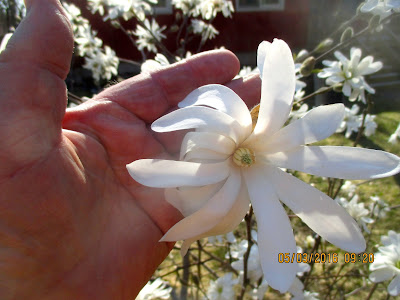 |
| YELLOWSTONE BULL ELK |
 |
| YELLOWSTONE BISON |
 | |
| ELK HERD ALONG US14 EAST OF YELLOWSTONE |
 |
| YELLOWSTONE TOURIST TAKING PHOTO OF GRIZZLY BEAR (WAY TOO CLOSE) |
 |
| ANTELOPE ON HWY US 14 EAST OF YELLOWSTONE |
Tuesday, 8:30 AM. 47 degrees F at the ferry dock, 44 on the back porch. Wind NNE, light with moderate gusts. The sky is overcast and thundershowers are possible this afternoon. The humidity is 87% and the barometer is falling, currently at 30.0". It evidently has been cool and wet at home while we were gone.
We arrived back in Bayfield last night, exhausted and with a brake dragging on the truck, but overjoyed at a wonderful trip. We are anxious to pick Buddy up from Blue Ribbon Kennels. The lawn needs mowing but lots of things came into bloom during our absence; Allium, more Iris, lots of flowering crab trees, lily-of-the valley, sweet woodruff, Oregon grape holly, lilacs, red elderberry and more.
Grandson Nick's high school graduation in Denver was a delightful event, and it took us a day to drive from Denver to Cody, Wyoming, east of Yellowstone National Park. Denver traffic is awful and it was a hassle to get out of the city. Once out of Denver it was a nice trip north. Cody was full of Chinese tourists heading for the park, and indeed the park itself was replete with Chinese and other foreign tourists. At times there were more foreign languages to be heard than English.
I have a lot of commentary on the park, but will get back in the swing of posting with a bit about the wildlife of Yellowstone and environs. Bison (buffalo) were everywhere, both inside and outside the park. When I was last in Yellowstone sixty years ago there were none.
We also saw mule deer (or maybe they were blacktailed deer), lots of elk (both inside and outside the park), and quite a few antelope outside the park. We looked for moose, wolves and bighorn sheep but were not fortunate enough to see those species from the truck. We saw a few black bear, and were overjoyed to see a grizzly bear, but were unable to get a decent photo of it. I did get a photo of a tourist taking a photo of the bear; he was way too close to the animal, which was thrashing around in the undergrowth about twenty-five yards away.
We also saw mule deer (or maybe they were blacktailed deer), lots of elk (both inside and outside the park), and quite a few antelope outside the park. We looked for moose, wolves and bighorn sheep but were not fortunate enough to see those species from the truck. We saw a few black bear, and were overjoyed to see a grizzly bear, but were unable to get a decent photo of it. I did get a photo of a tourist taking a photo of the bear; he was way too close to the animal, which was thrashing around in the undergrowth about twenty-five yards away.
Which reminds me of a Yellowstone tale from the late 1950's, when two acquaintances of mine (call them Dumb and Dumber) traveled to Yellowstone in a brand new Buick (those were the days when a young guy could get a good paying factory job and buy a new car).
Dumb, or perhaps Dumber, thought it would be cool to take a photo of a bear behind the wheel, so they enticed a roadside black bear into the driver's seat with a candy bar. The bear posed for the photo but was reluctant to leave until it got more candy. They had none. In its unhappiness the bear totally destroyed the inside of the automobile. My friends, sadder but wiser, drove a thousand miles back to Wisconsin sitting on peach crates.
Dumb, or perhaps Dumber, thought it would be cool to take a photo of a bear behind the wheel, so they enticed a roadside black bear into the driver's seat with a candy bar. The bear posed for the photo but was reluctant to leave until it got more candy. They had none. In its unhappiness the bear totally destroyed the inside of the automobile. My friends, sadder but wiser, drove a thousand miles back to Wisconsin sitting on peach crates.
Yellowstone is a fantastic landscape, created by the blowout and collapse of a huge volcano some 700,000 years ago, and the only thing that keeps it from blowing out again is the constant release of pressure by all the geysers and hot springs in the region. Eventually it will blow again, and take out much of the North American continent. Something else to worry about; keep it up, Old Faithful.
The next few posts will give some more insights regarding Yellowstone National Park, the first national park in the United States, and indeed in the world. Set aside from development by President Grant 144 years ago, it has been amazingly well preserved despite its popularity, and indeed Yellowstone led to the eventual creation of the National Park Service, which celebrates its 100th birthday this year.
Sometimes we get things right.
The next few posts will give some more insights regarding Yellowstone National Park, the first national park in the United States, and indeed in the world. Set aside from development by President Grant 144 years ago, it has been amazingly well preserved despite its popularity, and indeed Yellowstone led to the eventual creation of the National Park Service, which celebrates its 100th birthday this year.
Sometimes we get things right.
 is
is






















































